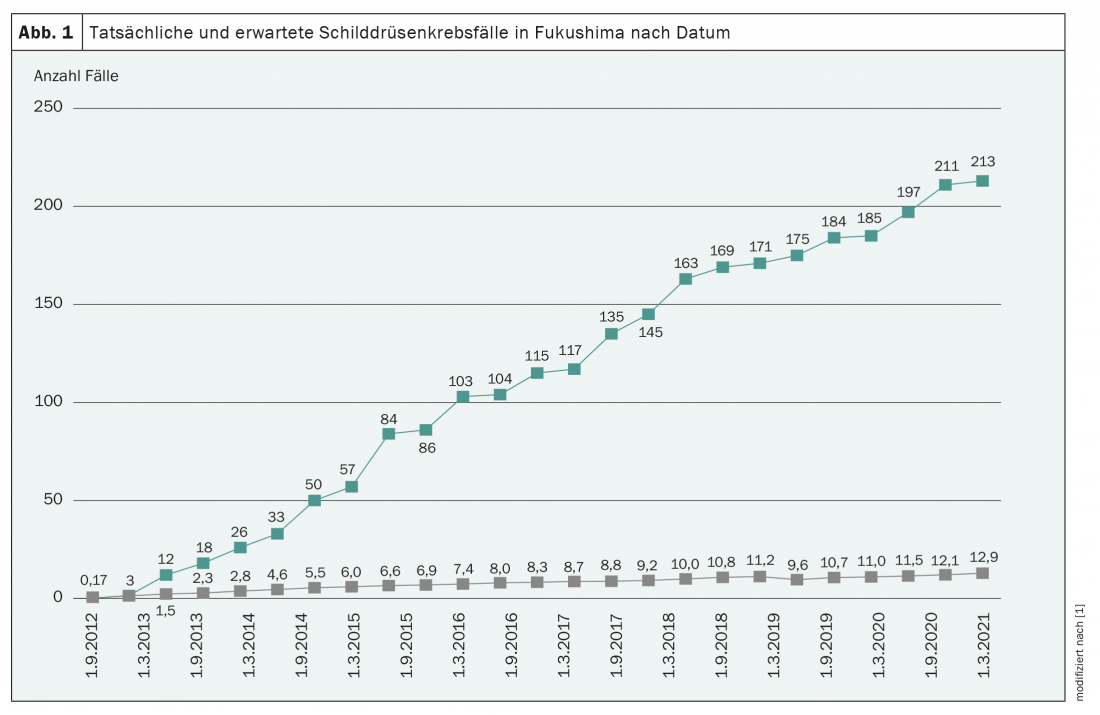For 40 years, IPPNW, the group of International Physicians for the Prevention of Nuclear War, has been working for a world without nuclear threats. Ten years after the nuclear disaster in Fukushima, a virtual symposium was held on February 27, 2021, to take stock, among other things, of the development of oncological diseases in the region. The conclusion: sobering.
That a nuclear incident like the one at Fukushima on March 11, 2011, has long-term effects on public health is hardly surprising. However, the extent of the health consequences is difficult to estimate and research, not least for political reasons. In a structured literature search, IPPNW analyzed in more detail the effects on cancer development ten years after the incident. The results were presented by Alex Rosen, MD, board member of the German IPPNW and senior physician for pediatrics at Charité Berlin.
Literature at a glance
A total of 57 publications were identified in December 2020 that addressed the development of thyroid cancer in the Fukushima region. Twelve others dealt with leukemia and eight with solid tumors related to the nuclear disaster. At first glance, a considerable number of studies, Alex Rosen found. However, only at first glance. This is because 28 of the publications on thyroid cancer were written by Fukushima Medical University and/or the International Atomic Energy Agency (IAEA), 18 of them even by one and the same person: Shunichi Yamashita, the former president of the Japan Thyroid Association and a great friend of the nuclear industry. Two other studies came directly from the pen of the nuclear industry. This left only eight neutral and scientifically serious publications on the occurrence of thyroid cancer in Fukushima, Rosen calculated. The research landscape on solid tumors and leukemias is even more meager, he said. The publications identified were largely concerned with incidental aspects such as technical solutions for detection or global incidences.
Focus on the thyroid gland
In order to be able to depict the oncological implications of the nuclear disaster, the pediatrician focused on the entity that has so far been best studied in this context due to the sparse data available: Thyroid carcinoma. This is well suited for epidemiological studies due to the comparatively short latency period until onset, the accessible and inexpensive diagnostics, and the low incidence in children in the general population. Changes in appearance can in fact be detected at an early stage through these properties.
Radioactive iodine, in particular the isotope iodine-131, plays a key role in its formation. This was emitted in droves on March 11, 2011 and subsequently polluted the surrounding areas. Like dust particles, the radioactive particles entered the air, were dispersed by the wind, collected in clouds, and finally fell back to earth as dangerous snow or rain. In March 2011, concentrations of radioactive iodine well above the limits were measured in almost all vegetable, milk and drinking water samples from the region. As late as June of that year, high levels of iodine-131 were detected in the soil – evidence of an extremely high initial dose or continuous release of radioactive material, according to Rosen. Or both. This is because the half-life of iodine-131 is only eight days.
While the cause of the prolonged detection of radioactive iodine in Fukushima will probably never be clearly explained, clear findings exist on the prevention of the consequential damage. Thus, the uptake of radioactive isotopes into the thyroid gland can be prevented by the prior administration of iodine tablets. These must be taken a few hours before the fallout. In 2012, an investigative commission concluded that such tablets were never distributed to the population in Fukushima, despite sufficient supplies and existing knowledge. This omission must be attributed to a conscious decision, headed by a man known to us from the various publications: Shunichi Yamashita, who still advises the authorities in Fukushima as a so-called Radiation Risk Management Advisor. On March 17, , 2011, he prevented the distribution of iodine tablets with the declared goal of preventing uncertainty among the population. Uncertainty that would have been entirely justified. This is because radioactive iodine not only accumulates in the thyroid gland for the production of thyroid hormones, but also enters the circulation and is easily absorbed by the placenta, thus also threatening the unborn child. Like all radioactive substances, iodine-131 can cause DNA mutations and thus lead to the development of cancer.
A conservative estimate by UNSCEAR (United Nations Scientific Committee on the Effects of Atomic Radiation), which is composed of representatives from countries with nuclear energy programs, estimates that the radiation dose to the thyroid gland of children in Japan in the first year after the nuclear disaster was 2.6 to 15 mGy, in Fukushima it was 15 to 83 mGy. For comparison, under normal circumstances, this is about 1 mGy per year. Based on these estimates, a total of about 1000 additional cases of thyroid carcinoma are expected in Japan. According to Alex Rosen, the actual number is probably much higher.
Problematic study
By failing to administer prophylactic iodine, the authorities contributed decisively to the cancer risk of a study population that has since undergone regular sonographic examinations by Fukushima Medical University. The so-called Thyroid Ultrasound Examination studyhas been running since 2011 and is the largest thyroid screening program in history to date. Children and young adults up to the age of 25 are examined. A diagnostic ultrasound is performed every two years to detect cysts, nodules and – in the worst case – cancer. The fifth round of this screening is currently underway. Despite major limitations, the data collected are extremely valuable for assessing cancer risk after the nuclear disaster. Alex Rosen emphasized that this is the only longitudinal study that systematically analyzes effects of the nuclear accident.
Screening was started on 300,000 under 18-year-olds. Currently, the study population still includes approximately 181,000 people, representing nearly 62% of affected children in the region. Thus, since the beginning of the studies, almost half of the participants have been lost. On the one hand, this is due to students dropping out, for example by moving away, Dr. Rosen explained, and on the other hand to the exclusion of all persons who turn 25. The opportunity to participate in a follow-up study was taken up by less than 10% of young adults. Thus, they are not only lost to data analysis, but also exposed to an increased risk of disease – without appropriate follow-up care. A development that is even encouraged by the authorities. For example, Alex Rosen told us that sex education classes in schools are primarily aimed at propagating the right not to know and downplaying a possible increase in incidence. The large-scale screening alone is held responsible for this.
In addition to this loss of participants and the restriction of data to those under 25, IPPNW criticizes other aspects of the study. Shunichi Yamashita is responsible for this, as well as for preventing the distribution of iodine tablets. Nor should the influence of the nuclear lobby be underestimated, Rosen warned. Since 2012, the IAEA has been acting in official cooperation with Fukushima Medical University.
According to IPPNW, the monopoly of the local university in the investigations leads to the loss of valuable data and potential manipulation cannot be detected. There were reports of superficial consultations that lasted only a few minutes. Families are often denied access to ultrasound images, which are kept strictly under lock and key. The university also strongly discourages obtaining second opinions and is even in contact with potential providers. And another point Rosen made in his presentation: If an abnormal finding is detected, further diagnostics in many cases take place outside the study and are therefore not included in the study results.
Despite everything: Interesting results
Despite these limitations, the Fukushima Medical University study already provided interesting results. Cysts and nodules of the thyroid gland increased with each screening to date, with 68% of participants affected in 2020. While not every abnormal finding develops into thyroid cancer, Rosen emphasized, the noticeable increase in thyroid cysts and nodules over the years does not bode well. In a similar study conducted in Tokyo between 2005 and 2013, the 1214 children included did not show comparable development.
A total of 198 cases of thyroid cancer were diagnosed by 2020, 101 of which were diagnosed during the first screening between 2011 and 2014. In addition, four patients who participated in the follow-up study for over 25-year-olds and eleven children who were examined outside the official study developed thyroid malignancy. According to projections, these 213 cancer cases compare with 13 cases of thyroid cancer expected without additional radiation exposure (Fig. 1) . According to Rosen, the annual increase in the discrepancy between expected and actual cases is particularly problematic. The expert estimates that the risk of developing thyroid cancer in the region is 20 times higher.

In addition to an increase in incidence over the years, significant regional differences are also evident in the study results. Thus, the risk of disease clearly correlates with the amount of radioactive fallout. In recent years, cancer cases have also been diagnosed in children born in 2011, who experienced exposure primarily in the womb.
And what about the other types of cancer?
While the data on thyroid cancer is not perfect, at least it exists. There are no structured studies on any other malignancies in Fukushima. In the absence of evidence in this area, Alex Rosen’s presentation presented estimates from the IAEA and WHO. These assume a 4% increase in risk for solid tumors, 6% for breast cancer, and 7% for leukemias. Figures that, according to IPPNW, are to be evaluated critically. Among other things, the increased vulnerability of unborn children had been neglected in the calculation and the authors were under considerable conflicts of interest.
The bottom line is that not only are the health effects of the nuclear disaster devastating – just as problematic is their realistic depiction and the handling of the consequences of radiation. In the confusion of political, scientific and economic interests, the health of the individual often falls by the wayside. Many diagnoses are made too late or missed entirely, Rosen was convinced. He clearly called for enabling independent studies in the region and better protection of the population. The focus must be on people’s right to health and a healthy environment, as well as their right to truthful information.
Source: lecture “Cancer in Fukushima – Analyzing the evidence after 10 years”, Alex Rosen, MD, at the IPPNW symposium “10 years of living with Fukushima”, virtual realization on Feb. 27, 2021.
Congress: IPPNW Symposium
Literature:
- Press release IPPNW: 10 years Fukushima 26.02.2021. http://ippnw.de/commonFiles/pdfs/Atomenergie/Fukushima/IPPNW_Digitale_Pressemappe_10_Jahre_Leben_mit_Fukushima.pdf (last accessed 03/06/2021)
InFo ONCOLOGY & HEMATOLOGY 2021; 9(2): 35-37.











